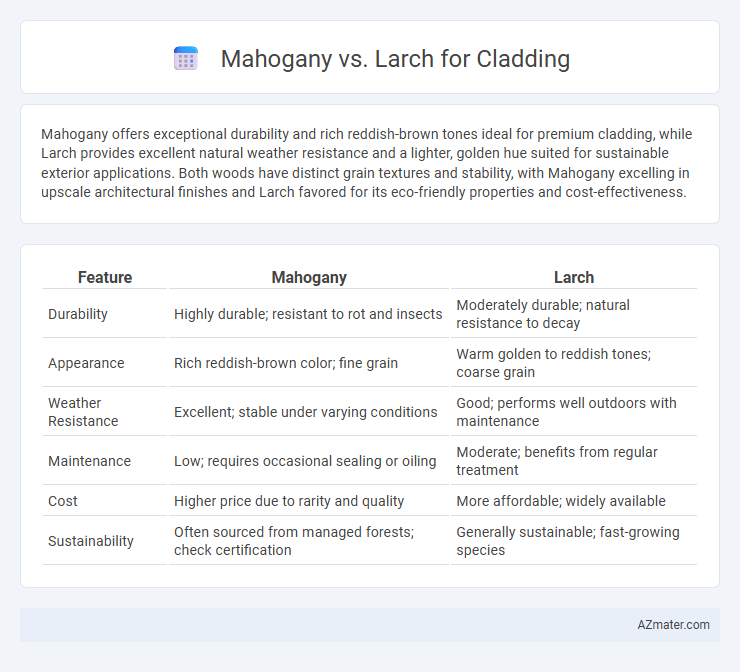Mahogany offers exceptional durability and rich reddish-brown tones ideal for premium cladding, while Larch provides excellent natural weather resistance and a lighter, golden hue suited for sustainable exterior applications. Both woods have distinct grain textures and stability, with Mahogany excelling in upscale architectural finishes and Larch favored for its eco-friendly properties and cost-effectiveness.
Table of Comparison
| Feature | Mahogany | Larch |
|---|---|---|
| Durability | Highly durable; resistant to rot and insects | Moderately durable; natural resistance to decay |
| Appearance | Rich reddish-brown color; fine grain | Warm golden to reddish tones; coarse grain |
| Weather Resistance | Excellent; stable under varying conditions | Good; performs well outdoors with maintenance |
| Maintenance | Low; requires occasional sealing or oiling | Moderate; benefits from regular treatment |
| Cost | Higher price due to rarity and quality | More affordable; widely available |
| Sustainability | Often sourced from managed forests; check certification | Generally sustainable; fast-growing species |
Introduction to Mahogany and Larch Cladding
Mahogany cladding is prized for its rich, reddish-brown hue, natural durability, and resistance to decay, making it a premium choice for exterior applications. Larch cladding offers a distinctive pale yellow to reddish tone with strong natural resin content that enhances weather resistance and longevity. Both woods provide excellent structural stability, but their unique grain patterns and color variations influence aesthetic preferences in architectural design.
Appearance and Aesthetic Qualities
Mahogany offers a rich, deep reddish-brown hue with a fine, straight grain that enhances its luxurious and classic appearance, making it ideal for high-end cladding projects. Larch displays a warm golden to reddish-brown tone with a pronounced grain pattern and natural resin knots, providing a distinctive, rustic charm and textured visual character. Both woods develop a silver-gray patina over time if left untreated, but Mahogany maintains a smoother finish while Larch's rugged texture accentuates its natural aesthetic appeal.
Durability and Longevity Comparison
Mahogany offers exceptional durability with natural resistance to rot, decay, and insect attacks, making it a long-lasting choice for cladding in harsh weather conditions. Larch, known for its high resin content, provides strong resistance to moisture and fungal decay, ensuring solid performance but generally has a slightly shorter lifespan than mahogany. In terms of longevity, mahogany typically outperforms larch by maintaining structural integrity and aesthetic appeal for decades with minimal maintenance.
Resistance to Weather and Decay
Mahogany offers superior resistance to weather and decay due to its dense, oily grain structure, making it highly durable in harsh outdoor conditions. Larch, while naturally resistant to rot and insect attack, has a more fibrous texture that can absorb moisture, requiring regular maintenance to prevent decay. Both woods perform well for cladding, but mahogany typically provides longer-lasting protection with less upkeep.
Maintenance Requirements
Mahogany cladding demands regular maintenance including sealing and staining every 1-2 years to protect against moisture and UV damage, preserving its rich color and preventing surface cracking. In contrast, larch requires less frequent upkeep, typically needing annual cleaning and occasional oiling to maintain its natural durability and weather resistance. Both wood types benefit from proper ventilation and protective finishes to extend their lifespan and enhance aesthetic appeal in exterior applications.
Environmental Impact and Sustainability
Mahogany, known for its durability and rich color, often comes from slow-growing tropical forests, raising concerns about deforestation and high carbon emissions during harvesting. Larch, a fast-growing softwood native to temperate regions, offers a more sustainable choice with its renewable supply and lower environmental footprint. Choosing FSC-certified larch wood ensures responsible forestry practices, making it a better option for eco-conscious cladding projects.
Cost Analysis: Mahogany vs Larch
Mahogany cladding typically incurs higher initial costs due to its dense grain structure and durability, making it a premium investment compared to larch. Larch offers a more budget-friendly option with moderate longevity, balancing cost and performance for cladding projects. Maintenance expenses for mahogany remain lower over time owing to its natural resistance to decay, whereas larch may require more frequent treatments to preserve its appearance and structural integrity.
Installation and Workability
Mahogany offers smooth workability with fine grain that allows precise cutting and sanding, making it ideal for detailed cladding installation. Larch is denser and more resinous, requiring sharp tools and more effort during fitting, but its natural durability enhances long-term cladding performance. Both woods respond well to nails and screws, though pre-drilling is recommended for larch to prevent splitting.
Performance in Different Climates
Mahogany offers superior durability and natural resistance to moisture, making it ideal for wet and humid climates where rot resistance is crucial. Larch, with its dense grain and high resin content, excels in cold and temperate regions by providing strong weather resistance and stability against freezing and thawing cycles. Both woods require proper maintenance, but mahogany generally outperforms larch in tropical climates due to its enhanced resistance to decay and insect damage.
Mahogany vs Larch: Which Is Best for Your Project?
Mahogany offers exceptional durability and rich, deep reddish-brown hues that enhance the aesthetic appeal of cladding projects, making it ideal for high-end applications requiring long-lasting beauty. Larch provides a more cost-effective option with natural resistance to decay, featuring a lighter, warm tone that weathers beautifully over time, suitable for rustic or contemporary designs. Choosing between mahogany and larch depends on budget, desired color palette, and maintenance commitment, with mahogany excelling in luxury and longevity, while larch balances durability and affordability.

Infographic: Mahogany vs Larch for Cladding
 azmater.com
azmater.com